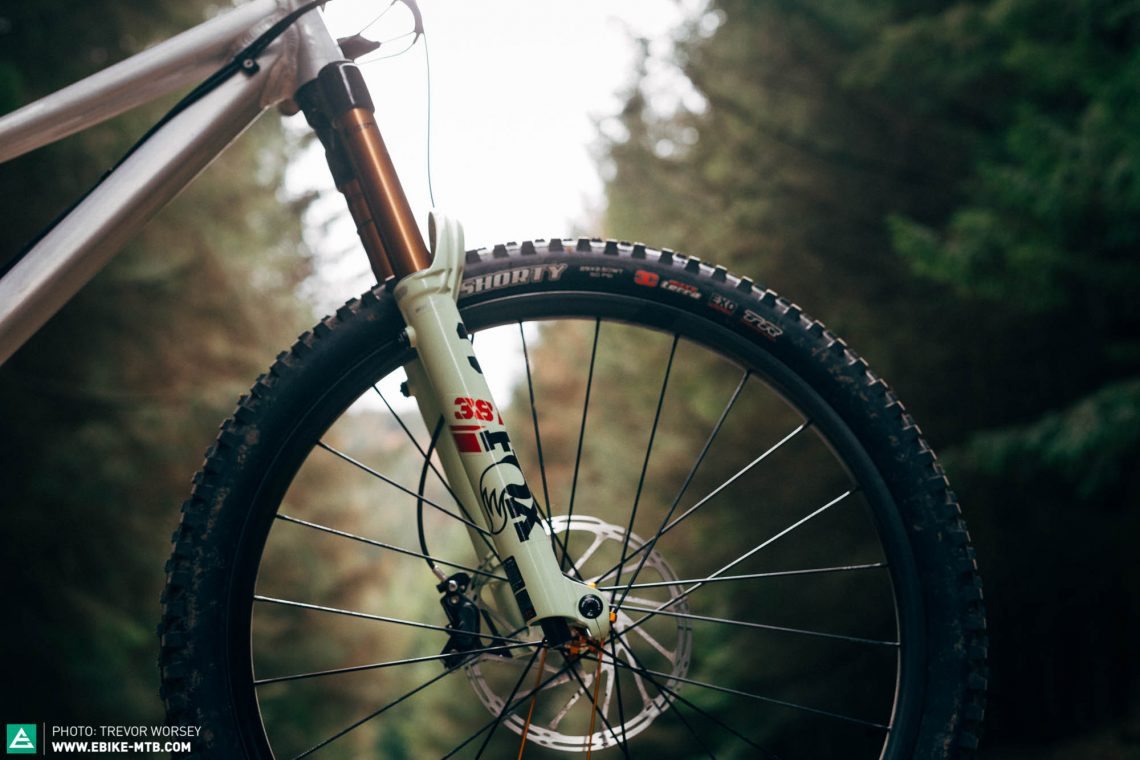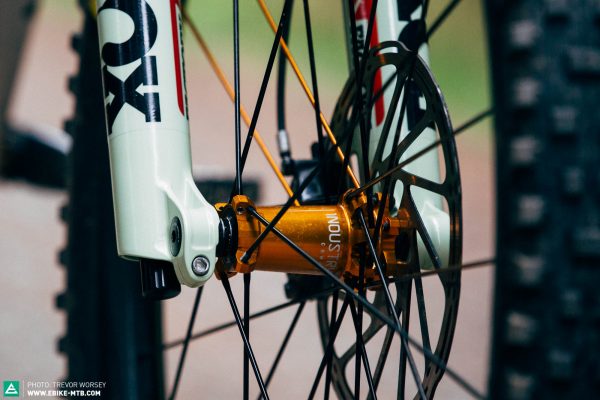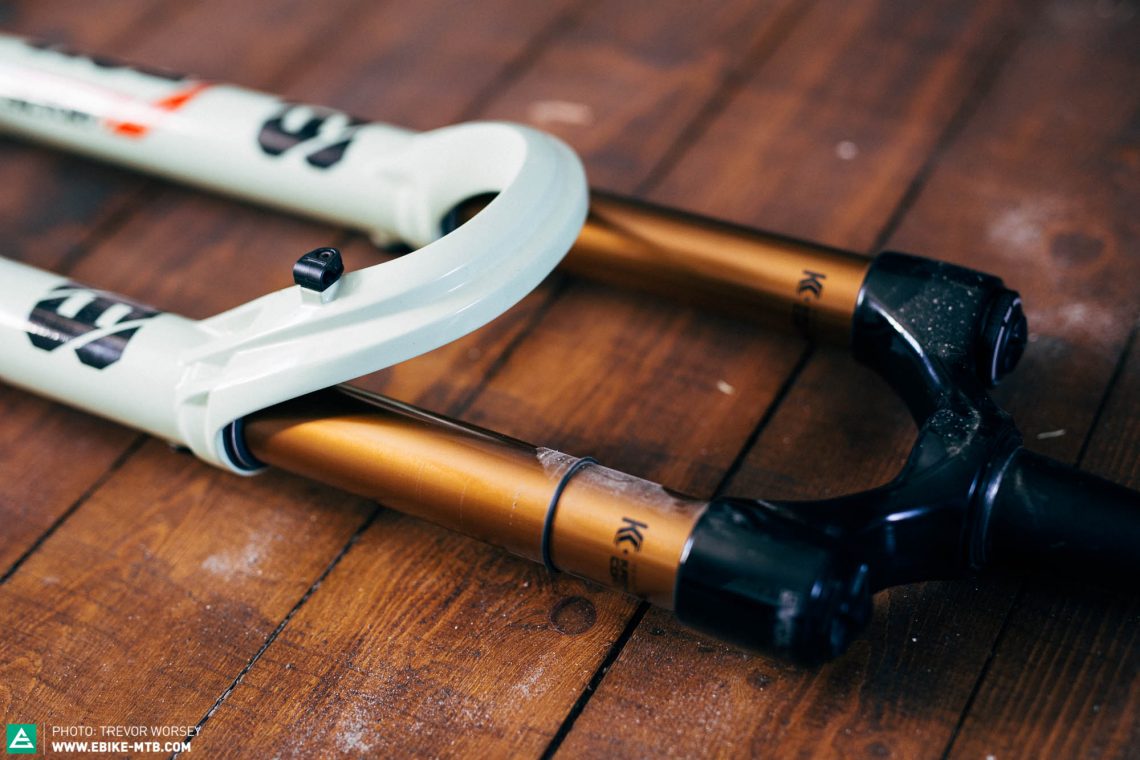The FOX 38 is out, and now all your forks look skinny! However, the new FOX FLOAT 38 suspension fork is far more than a fat FOX 36. We dive inside the new fork to take a closer look.

The development of the new FOX 38 was perhaps one of the world’s worst kept secrets, the distinctive bleed valves and round crown have already been well publicised in many spy shots. As eMTBs grow increasingly capable, demand for higher-performance parts is accelerating, especially parts that increase strength and performance. The current FOX 36 was already an accomplished performer, however the new FOX 38, with i’s wider 38 mm stanchions, brings new levels of strength and chassis stiffness. FOX have now ‘downgraded’ their 36 chassis to an ‘all-mountain’ fork (in shorter 150-160 mm travel options) and are introducing the FOX 38 for all ‘160 – 180 mm duties. Bigger, stiffer and with new internals, the FOX 38 FLOAT is now the brand’s big-hitter single clamp.

The new FOX 38, all you need to know in one paragraph
There is a lot of tech inside the new FOX 38, so if you just want the essentials without any marketing spin or tech deep-dives, here’s all you need to know in one paragraph. The new FOX 38 has 38 mm stanchions and is FOX’s new fork for enduro duties with 160-180 mm of travel. It will be available in Factory, Performance Elite, Performance, and E-Bike models with GRIP2 and GRIP dampers, in 27.5 and 29” options. FOX will now only be using tapered steerers on their gravity forks, with no 1 ⅛ steerer option. Besides the extra-fat stanchions it has a new rounded arch and internally ovalised steerer tube for increased strength and stiffness. The fork features a new floating axle design for perfect alignment with your hub. Internally the FOX 38 has new air channels that allow air and oil to migrate easier inside the fork helping lubrication and spring performance. Bleed ports on the back allow for atmospheric air pressure equalization. The air spring piston now sits inside an floating air sleeve, instead of inside the fork stanchion, allowing the fork to flex without binding and decreasing seal head friction. FOX have revised the GRIP2 damper, adding VVC (Variable Valve Control) to the High Speed Compression circuit. The fork weighs 2213g (our 170 mm 29er FACTORY model) and costs from €1259 to €1589.

New FOX 38 features at a glance
- New chassis with, lower leg bleeders, air/oil channels, floating axle, and new arch shape to improve head tube clearance
- Tapered and elliptical steerer tube
- GRIP2 damper now with VVC (Variable Valve Control), and reduced 8-click HSC and HSR adjustment
- Travel option(s): 160mm-180mm
- 31% stiffer transverse shear, 17% stiffer fore/aft and 38% torsionally stiffer than 36
- Wheel size(s): 27.5″ and 29″
- Offset(s): 37mm, 44mm and 51mm
- 58mm crown diameter to match modern frame shape profiles
- Optional mud guard
- Available in Factory, Performance Elite, Performance, and E-Bike models with GRIP2 and GRIP dampers
- Weight: 2213 g (our 170 mm x 29” model with a 20 cm steerer)
- Price: EUR €1259 – €1589
What’s with the new FOX round arch?
The first change that is immediately apparent is the new round arch, in place of the usual squared-off design as featured on the outgoing range. According to FOX, the new round arch is not a design element, it was created using FEA (Finite Element Analysis) to measure the way the forces travel through the structure of the fork. Love it or hate it, this is what the FOX engineers say is the best possible design to get maximum strength in the chassis. FOX is not aiming to be the stiffest, but the most comfortable. Reducing fatigue on the forearms, with a little compliance. Eagle eyed readers will notice that the arch now sits noticeably further from the fork chassis, requested by riders who wanted to run a reach-adjust headset and so needed increased clearance.


The new FOX 38 is stiffer than a 36
In the pursuit of more performance and chassis stiffness, FOX have increased the stanchion size to 38 mm on the FOX 38, sitting in the middle ground between a FOX 36 and a FOX 40. FOX have also ovalised the interior of the steerer tube, while the outside diameter is round, the inside diameter is ovalised, thicker at the front and back. Combined with a new crown and the new round arch, FOX claim the 38 model has a 31% increase in transverse shear (bending), is 17% stiffer fore and aft (think hard braking) and 38% torsionally stiffer than a 36. This means that the new 38’s, and the 36’s, are now certified for use with 230 mm front rotors (click for more info).

Chassis stiffness is only one half of the equation, what is also important with any fork is that the fork legs maintain a good alignment. There’s no point in manufacturing to a high tolerance if the dimensions of your front hub are narrower or wider than the standard requires, splaying or pinching your fork legs and reducing the effectiveness of the fork. FOX has developed two new axle designs to eliminate this. The 15QR tool-free quick release axle uses a floating design with a ‘set-once’ alignment spacer, where you first preload the hub with the alignment spacer, once tightened with a pinch bolt you now have the perfect fit between the fork and your personal hub. With the lighter but non quick-release Kabolt-X, the axle end is free to float inside the fork leg, to ensure perfect alignment, you compress the fork 50% and tighten the 6 mm pinch bolt. Both the new axles ensure the legs are always inline, and should not bind. There will no longer be a 20 mm option, only 15 mm.


What are the air bleeders on the back of the FOX 38 for?
Externally, you cannot miss the two air bleeder valves on the back of the FOX 38 lowers, internally, behind these valves small channels allow air to migrate through the fork as it compresses and extends, opening up new volumes. As the fork compresses and extends, this very fast airflow draws oil up to the bushings and foam rings to help lubricate the fork. The channels also reduce pressure buildup in the lower part of the fork, which can inhibit the fork from reaching full travel. If you use lifts a lot, or travel to higher trails, the air bleeders allow you to equalise the internal pressure to the atmospheric pressure at the press of a button, so the fork will always feel the same, no matter the elevation.



The FOX 38 has a new GRIP2 damper
The GRIP2 damper has also seen big changes in design (which will also feature on the new 2021 FOX 36) with the VVC (variable valve control) technology now being included on the high-speed compression side too. While hard to explain unless you have looked inside the fork, instead of a preload spring, VVC uses a rotating leaf spring to preload the high speed compression shim stack. As you rotate the dial, the leaf spring arms rotate around a support that ‘spirals’ outward, the more the spring travels around the spiral the more the leverage curve reduces. Instead of preloading a fixed spring, VVC changes the fulcrum of leverage on the shims, reducing the initial threshold to overcome the spring tension and giving a smoother blow off. The effect is more like revalving the entire shim stack than increasing the preload. FOX have also reduced the number of clicks on both the High-Speed Rebound and High-Speed Compression adjusters to 8, to simplify setup.

Changes to the FOX 38 EVOL air spring
There have also been some big changes inside the FOX 38’s air spring. Unlike most forks (including the 36) where the spring piston runs down the inside diameter of the fork stanchions, FOX now uses a floating machined air sleeve. This air sleeve is free to move slightly inside the stanchion, so the piston can maintain a smooth path even if the fork is twisting. This results in improved function when experiencing torsional loads like off-camber sections and heavy braking, The addition of a sleeve means the inside diameter is reduced, and the 38 uses the same piston head size as a FOX 34. The narrower sleeve means the fork runs on slightly higher pressures, but the advantage is that the seal diameter is also smaller so the seal friction is less.
First ride review of the FOX 38 FLOAT FACTORY
We received our test FOX 38 FLOAT FACTORY 170 mm 29er fork a couple of weeks before the UK went into lockdown due to Coronavirus. We were able to get some quick initial impressions when built into a RAAW Madonna V1. To see what setup FOX recommends, we followed the recommended settings in the comprehensive setup guide (for our 83kg tester). The sleeved air spring reduces the internal spring dimensions and as such we needed to add more air than we would normally in a current FOX 36, taking us to 97 psi. FOX recommends 5 and 4 clicks (from closed) of High Speed Rebound and Low Speed Rebound respectively, also suggesting 5 clicks of High Speed Compression, and 10 clicks of Low Speed Compression. After holding the air bleeders for 5 seconds we were good to go.
Using the recommended settings, the fork felt very plush and active through the initial part of the stroke, but with a firm ramp in the last third of the travel. The new 8 position VVC high speed compression adjuster is easier to use, increasing or decreasing the damping a few clicks noticeably increases or decreases the ramp of the fork and how firm it feels during a big hard hit. We were a little disappointed that on our fork the low speed rebound adjuster ‘clicks’ are VERY hard to feel, as the rest of the adjustment detents are very positive.

Overall we were impressed with the FOX setup guide and the feel of the fork out of the box, with only some small adjustments to personal preference. If you want to check out how we optimise our suspension, you can check our suspension fork setup guide here.
First ride impressions of the new FOX 38 FLOAT FACTORY
“My FOX 36 is just too flexy” is probably a statement that very few have made, however, anyone who has ridden a FOX 40 will know how much more precisely a stiffer chassis will steer through rough terrain. It’s true, there’s often an inverse relationship between stiffness and comfort, but when you are talking about elite enduro racing (FOX are unashamedly a high-performance race orientated brand and this is where they target the fork) you want to have the most accurate steering possible. The FOX 38 looks and feels burly on the front of the bike, and steers very positively, with minimal flex if you twist the front wheel laterally. The increase in chassis stiffness is also noticeable under very hard braking, where we observed minimal tucking backwards at the axle.

While more testing is needed to see how the fork performs on a variety of trails, it’s already clear that the new FOX 38 will certainly have many applications on the latest long travel 29er enduro bikes, and especially the eMTB sector where a stiffer chassis is essential to handle the additional system weight – especially as it’s only 200g heavier than the FOX 36 and RockShox Lyrik. We did not get the opportunity to fully explore the damper’s performance on long runs, but we will update this review as soon as we have had more shuttle time.
Conclusion
While we have a FOX 38 currently on test, it would be irresponsible at this time to push the FOX 38 to the limit (as we would be taken to the very edge of ours), but as soon as restrictions ease we will hammer the 38 against the current 36 and Rockshox Lyrik. However, initial testing and setup before the lockdown indicates that the FOX 38 feels far more like a mini 40 on the trail than a beefed up 36. The chassis steers with total authority, and we like the simplified adjustment on the High Speed Compression. We still need some serious shuttle time before we can draw full conclusions, but the new FOX 38 appears to be the perfect solution for those looking for downhill fork capability, in a single crown package.
For more information head to ridefox.com
Did you enjoy this article? If so, we would be stoked if you decide to support us with a monthly contribution. By becoming a supporter of E-MOUNTAINBIKE, you will help secure a sustainable future for high-quality cycling journalism. Click here to learn more.
Words & Photos:









